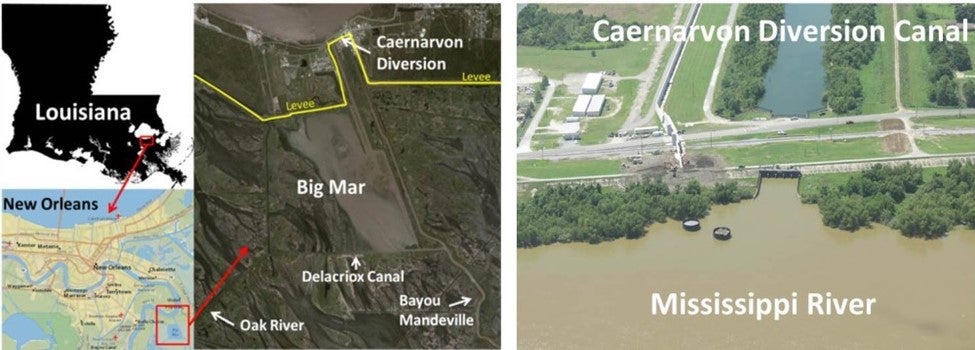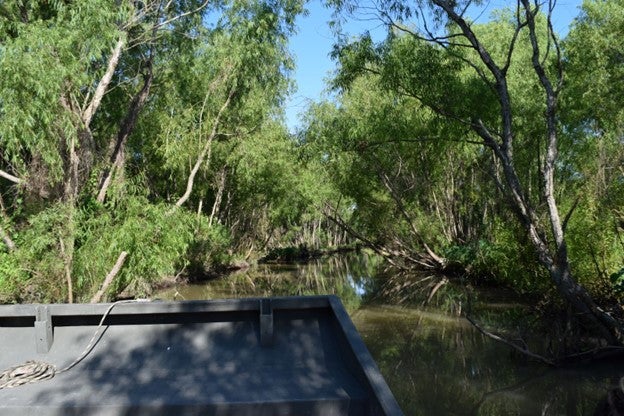A View From Above: The Unintentional Land Building Success Story of Caernarvon
The scale of Louisiana’s land loss crisis – and the work being done to preserve it – can be hard to grasp from the ground. One of the best education and advocacy tools for coastal restoration is to fly people over the coast to see the scale and impacts of our land loss crisis. While we can’t bring everyone up on a plane, we can do our best to bring that perspective to you here. In this blog series, we are following a virtual flyover path down the lower Mississippi River and looking at past and future projects impacting our coastline. Check out the other posts in this series.
Welcome back to our flight down the Mississippi River and along the coast. Today we look at the Caernarvon Freshwater Diversion, which began operating in Plaquemines Parish in August of 1991. The objectives of the project were to reduce marsh loss, enhance emergent vegetative growth, and increase the productivity of fish and wildlife in the area.

Photo credit: Pontchartrain Conservancy
The wetlands of Louisiana were built by the sediment carried by the Mississippi River. Annual flooding would supply the marshland with freshwater, sediments, and nutrients every spring. The flooding supported the ecosystem’s environmental gradient by creating habitats of varying salinity levels able to support a large range of plants and animals. Levees that were constructed to protect communities from devastating floods interrupted the annual nourishment of the wetlands. Without the consistent addition of fresh water and sediments, saltwater intrusion caused the swamps and marshes to begin to degrade, and the environmental gradient of nutrients and salinity was disturbed.
Over 3,000 acres of marsh have been lost and converted to open water in the Breton Sound basin since 1956. This disconnection from the river not only affected the land but also organisms that inhabit the area. Throughout the 20th century, commercial oyster farmers witnessed significant declines in the local oyster populations. The declines were attributed to widespread disease, elevated salinity levels outside the oysters’ range of habitation and an influx of saltwater predators to the area. After seeing the immediate increase in oyster production in response to river diversion projects such as the Bohemia Spillway and the Bayou LaMoque Diversions, local oyster farmers persuaded state officials to pursue the Caernarvon Diversion in 1987. Fortunately, the diversion went beyond just reinvigorating the oyster farming industry and enabled the estuary’s ecosystem to balance.
Land Building
The Caernarvon diversion structure consists of five gated box culverts with vertical lift gates that control the flow of water that travels through a long channel before entering Big Mar Pond. When the fast moving river water hits the shallow pond, it is slowed down, allowing for sediment to build up. Heavy sediments are deposited near the outflow channel, and the remaining sediments are deposited along the way, creating a variety of habitats. The diversion is operated by Louisiana’s Coastal Protection and Restoration Authority, which collaborates with the U.S. Army Corps of Engineers to manage budgetary and maintenance needs.
Bayou Bonjour: Caernarvon Freshwater Diversion Builds Land in Coastal Louisiana
After 14 years of operation, mudflats became visible in 2005. The Pontchartrain Conservancy began enhancing the habitat in 2010, planting trees in the outfall area and monitoring their growth for the next decade. The native swamp tree species were planted in the newly developed areas to help establish coastal forests that will perform a variety of ecosystem services. For instance, agricultural runoff carried by the Mississippi River is known to cause dead zones due to the excessive amount of nitrogen and phosphorus it possesses. Fortunately, wetland plants can benefit from this runoff by absorbing the excess nutrients and turning them into biomass, which enables them to grow faster, taller, and with deeper roots. In fact, year after year, the fastest growth rates of trees have been recorded at sites with diversions when compared to sites without diversions, such as Maurepas Swamp. As a result, these environments are strengthened, and their future success is bolstered.
Since the diversion began operation, more than 700 acres of new land have been added and over 42,000 trees have been planted as a part of restoration efforts. To date, the data shows an overall survival rate of 61% for the trees planted in the diversion outfall area. Through numerous volunteer and commercial efforts, the Pontchartrain Conservancy has learned that there is no single approach to restoration and that progress is not always linear.

Photo credit: Pontchartrain Conservancy
Despite the encouraging land building in the area, the diversion is only operated to manage the basin’s salinity. This is because the diversion was authorized by Congress to operate under its initial objectives under the Flood Control Act of 1965 and the Water Resource Development Acts of 1974, 1986, and 1996. The site is now in a 46-year-long monitoring phase that operates with an average annual discharge rate of about 3,000 cubic feet per second (cfs). For context, the Caernarvon Diversion site was designed to re-introduce up to 8,000 cfs of freshwater into the Breton Sound basin compared to the Mid-Barataria Sediment Diversion, which is specifically designed to build land in the Barataria Basin and will have a max flow of 75,000 cfs

The operation of the Caernarvon Diversion site has resulted in over 30 years of invaluable research and monitoring that will continue to serve as an example of what can happen when we allow the river to be reconnected with our wetlands. Louisiana’s coastal communities are not only experiencing unprecedented land loss but also stronger hurricanes, increasingly devastating storm surges, sea level rise, and subsidence. Preserving wetlands benefits ecologically important ecosystems and wildlife, commercial industries, levees, and communities alike, and diversions are key to this effort. If Caernarvon, as a freshwater diversion, was able to become a land-building success, consider the success of upcoming sediment diversion projects.